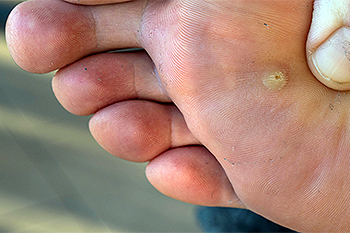6650 Frankford Ave
Philadelphia, PA 19135

The metatarsals are long bones in the foot that link the toes with the heel and arch. When these metatarsal bones are repeatedly stressed over time (as opposed to a sudden or acute injury), a stress fracture can occur. The second and third metatarsals are the most commonly injured, and can occur more frequently in military recruits, athletes and dancers who run and jump regularly. Metatarsal stress fractures can be caused by overtraining, long-distance running, having poor body mechanics or running form, pushing your body beyond your fitness level, or training with improper footwear or on hard surfaces. Having diabetes or certain forms of arthritis can also increase your risk factors, as can vitamin D or calcium deficiencies. Signs of a metatarsal fracture include pain in the metatarsal(s), as well as tenderness, or swelling in the area. If you have symptoms like these, it is suggested that you stop participating in physical activity until you can be examined and evaluated by a podiatrist. If you do have a metatarsal fracture, your podiatrist may treat it with rest, stretching and/or muscle strengthening exercises, icing, immobilization, casting, prescription footwear, and more.
Activities where too much pressure is put on the feet can cause stress fractures. To learn more, contact John M. Fanelly, DPM from Northeast Philadelphia. Our doctor can provide the care you need to keep your pain free and on your feet.
Dealing with Stress Fractures of the Foot and Ankle
Stress fractures occur in the foot and ankle when muscles in these areas weaken from too much or too little use. The feet and ankles then lose support when walking or running from the impact of the ground. Since there is no protection, the bones receive the full impact of each step. Stress on the feet can cause cracks to form in the bones, thus creating stress fractures.
What Are Stress Fractures?
Stress fractures occur frequently in individuals whose daily activities cause great impact on the feet and ankles. Stress factors are most common among:
Symptoms
Pain from the fractures occur in the area of the fractures and can be constant or intermittent. It will often cause sharp or dull pain with swelling and tenderness. Engaging in any kind of activity which involves high impact will aggravate pain.
If you have any questions please feel free to contact our office located in Philadelphia, PA . We offer the newest diagnostic and treatment technologies for all your foot and ankle needs.
Middle joints in the second, third, and fourth toes can sometimes become deformed due to an imbalance in tendons, muscles, and ligaments. When this occurs, the toe is unnaturally bent with the middle joint stuck in an upward position while the rest of the toe is bent downward. This deformity causes the toe to look almost like a hammer, which is why it is known as hammertoe. Mallet toe is similar, however, the joint nearest the nail is affected. The factors that can contribute to hammertoe include wearing high heels or other footwear that crowds the toes, throwing the toes out of alignment by stubbing or injuring them, having an imbalance in the toe muscles due to age or other conditions, inheriting a second toe that is longer than the big toe, and suffering from diabetes, arthritis, or other conditions that compromise the feet. It is important to seek treatment from a podiatrist in the early stages of hammertoe, while the toe is still flexible, and the condition is more easily correctable. If your toe is always bent or it looks red or feels stiff or painful at the joint, it is a good idea to make an appointment with a podiatrist to get it examined and to discuss your treatment options.
Hammertoes can be a painful condition to live with. For more information, contact John M. Fanelly, DPM of Northeast Philadelphia. Our doctor will answer any of your foot- and ankle-related questions.
Hammertoe
Hammertoe is a foot deformity that occurs due to an imbalance in the muscles, tendons, or ligaments that normally hold the toe straight. It can be caused by the type of shoes you wear, your foot structure, trauma, and certain disease processes.
Symptoms
Risk Factors
Treatment
If you have hammertoe, you should change into a more comfortable shoe that provides enough room for your toes. Exercises such as picking up marbles may strengthen and stretch your toe muscles. Nevertheless, it is important to seek assistance from a podiatrist in order to determine the severity of your hammertoe and see which treatment option will work best for you.
If you have any questions, please feel free to contact our office located in Philadelphia, PA . We offer the newest diagnostic and treatment technologies for all your foot care needs.
 You may have broken your toe if you dropped a heavy object on it or hit it on a piece of furniture and it hurts – sometimes so bad you cannot move the toe. This can also happen if you play sports and injure your toe. Most of the time if you break a toe, it should be taped to the toe next to it and you should stay off the foot as much as possible until it feels better. This is not the case if the broken bone protrudes from the skin, more than one toe is affected, or you think you broke your big toe - as more treatment is necessary. Broken toes at the end of the foot, such as the pinkie or big toe, tend to be more painful because more pressure is put on them when walking and they are more likely to swell. As blood and liquid collect at the site of the broken toe it will start looking bruised, it may appear deformed like it is no longer lining up with other toes, and/or it can feel weak. It is very important to seek the counsel of a podiatrist if you suspect you have a broken toe. As mentioned, certain situations are worse than others so it is suggested that a podiatrist take an X-ray for a proper diagnosis, and then a corresponding treatment plan can begin.
You may have broken your toe if you dropped a heavy object on it or hit it on a piece of furniture and it hurts – sometimes so bad you cannot move the toe. This can also happen if you play sports and injure your toe. Most of the time if you break a toe, it should be taped to the toe next to it and you should stay off the foot as much as possible until it feels better. This is not the case if the broken bone protrudes from the skin, more than one toe is affected, or you think you broke your big toe - as more treatment is necessary. Broken toes at the end of the foot, such as the pinkie or big toe, tend to be more painful because more pressure is put on them when walking and they are more likely to swell. As blood and liquid collect at the site of the broken toe it will start looking bruised, it may appear deformed like it is no longer lining up with other toes, and/or it can feel weak. It is very important to seek the counsel of a podiatrist if you suspect you have a broken toe. As mentioned, certain situations are worse than others so it is suggested that a podiatrist take an X-ray for a proper diagnosis, and then a corresponding treatment plan can begin.
A broken toe can be very painful and lead to complications if not properly fixed. If you have any concerns about your feet, contact John M. Fanelly, DPM from Northeast Philadelphia. Our doctor will treat your foot and ankle needs.
What to Know About a Broken Toe
Although most people try to avoid foot trauma such as banging, stubbing, or dropping heavy objects on their feet, the unfortunate fact is that it is a common occurrence. Given the fact that toes are positioned in front of the feet, they typically sustain the brunt of such trauma. When trauma occurs to a toe, the result can be a painful break (fracture).
Symptoms of a Broken Toe
Generally, it is best to stay off of the injured toe with the affected foot elevated.
Severe toe fractures may be treated with a splint, cast, and in some cases, minor surgery. Due to its position and the pressure it endures with daily activity, future complications can occur if the big toe is not properly treated.
If you have any questions please feel free to contact our office located in Philadelphia, PA . We offer the newest diagnostic and treatment technologies for all your foot and ankle needs.
 Plantar warts develop on the bottom of the feet. They grow into the skin as a result of pressure that is exerted while walking or running. They can cause severe pain and discomfort, and it can be difficult to complete daily activities. Plantar warts are associated with the human papillomavirus (HPV) and live in warm and moist areas. These can include shower room floors, public pools, and locker rooms. The virus can enter the body through small cracks in the skin and wearing appropriate shoes while in these environments can help to reduce exposure. The wart appears to be a thickened area of hard skin, and they often have small black dots in the center. There are several treatment methods available, and it is strongly advised that you consult with a podiatrist if you are afflicted with plantar warts.
Plantar warts develop on the bottom of the feet. They grow into the skin as a result of pressure that is exerted while walking or running. They can cause severe pain and discomfort, and it can be difficult to complete daily activities. Plantar warts are associated with the human papillomavirus (HPV) and live in warm and moist areas. These can include shower room floors, public pools, and locker rooms. The virus can enter the body through small cracks in the skin and wearing appropriate shoes while in these environments can help to reduce exposure. The wart appears to be a thickened area of hard skin, and they often have small black dots in the center. There are several treatment methods available, and it is strongly advised that you consult with a podiatrist if you are afflicted with plantar warts.
Plantar warts can be very uncomfortable. If you need your feet checked, contact John M. Fanelly, DPM from Northeast Philadelphia. Our doctor will assist you with all of your foot and ankle needs.
About Plantar Warts
Plantar warts are the result of HPV, or human papillomavirus, getting into open wounds on the feet. They are mostly found on the heels or balls of the feet.
While plantar warts are generally harmless, those experiencing excessive pain or those suffering from diabetes or a compromised immune system require immediate medical care. Plantar warts are easily diagnosed, usually through scraping off a bit of rough skin or by getting a biopsy.
Symptoms
Treatment
To help prevent developing plantar warts, avoid walking barefoot over abrasive surfaces that can cause cuts or wounds for HPV to get into. Avoiding direct contact with other warts, as well as not picking or rubbing existing warts, can help prevent the further spread of plantar warts. However, if you think you have developed plantar warts, speak to your podiatrist. He or she can diagnose the warts on your feet and recommend the appropriate treatment options.
If you have any questions please feel free to contact our office located in Philadelphia, PA . We offer the newest diagnostic and treatment technologies for all your foot and ankle needs.